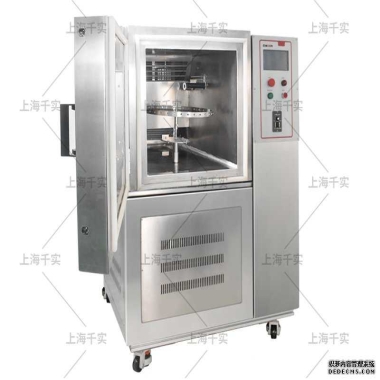What is an ozone test chamber?
An Ozone test chamber contains one or more ozone generators that operate on the principle of corona discharge. During corona discharge, oxygen molecules in dry air are excited by a high-voltage electric field, decomposing into individual oxygen atoms, which then combine with another oxygen molecule to form ozone (O3). The concentration of ozone produced can be controlled by adjusting the current and voltage of the generator.
Ozone testing is a method for evaluating the weather resistance and anti-aging properties of materials. In ozone testing, samples are placed in a sealed test chamber, and a certain concentration of ozone gas is injected into the chamber. Under specific temperature and humidity conditions, the samples are aged under the influence of ozone. Changes in the samples, such as appearance, physical properties, and chemical properties, are observed over a period of time to evaluate the samples' ozone aging resistance.
Ozone resistance testers are suitable for exposing products to a sealed, constant temperature and ozone environment. After a period of static or dynamic stretching, the degree of cracking or other changes in physical properties of the specimens are examined to assess the ozone aging resistance of rubber. The ozone resistance testing chamber provides continuous ozone measurement and control functions. This measurement system is based on Beer-Lambert's Law and utilizes ultraviolet absorption, requiring no chemical reagents and offering simple operation. After setting the desired ozone concentration and temperature on the human-machine interface (HMI), the PLC control system automatically reaches and maintains the ozone concentration, temperature, and humidity within the test chamber. The automatic ultraviolet measurement system can continuously and rapidly calculate the accurate ozone concentration even under varying flow rates. It boasts advantages such as ease of measurement, speed, and strong anti-interference capabilities. Furthermore, as a non-destructive physical testing method, it can be used for continuous real-time monitoring.

The Principle of Ozone Testing
The principle of ozone testing lies in the fact that ozone is a strong oxidant that can cause aging in materials, including organic materials such as rubber and plastics. In an ozone atmosphere, ozone molecules decompose to produce oxygen free radicals. These free radicals can initiate oxidation reactions, leading to material chain breakage and performance degradation.
With the advancement of technology, the applications of materials are becoming increasingly widespread. Ensuring the performance stability of materials under different environmental conditions has become a research hotspot. Ozone aging testing, as an important material testing method, can effectively assess the durability of materials in ozone environments, providing a scientific basis for product design and production.
Ozone (O₃) is a strong oxidant that can cause severe aging effects on a variety of materials. Especially for polymer materials such as plastics and rubber, ozone aging can lead to problems such as surface cracking, fading, and decreased strength. Therefore, ozone aging testing is particularly important. This test can simulate the ozone environment that materials may encounter during actual use to assess their ozone resistance and service life.
During ozone aging tests, laboratories typically place material samples in a specialized ozone aging chamber, adjusting the temperature and humidity to accelerate the aging process through contact with ozone. During the test, researchers periodically monitor changes in the sample's appearance, physical properties, and chemical composition. This data allows for the development of a material durability assessment model, providing a reference for subsequent material improvements.
Types of Ozone Tests:
Static Tests:
- The sample is fixed on a sample holder, exposed to air, and kept parallel to the airflow direction.
- The test is conducted in a closed test chamber, observing the sample's performance and surface changes under specified temperature and humidity conditions.
Dynamic Tests:
- The sample undergoes physical stresses such as tension, bending, and compression in an ozone aging test chamber.
- Dynamic tests can be intermittent or continuous:
- Intermittent: After stretching to a certain time and holding at the maximum value, the test is repeated as a static test.
- Continuous: The test is repeated cyclically, starting from 0 and stretching to the maximum value.
Test Procedure
- Place the sample in the ozone aging test chamber;
- Adjust the temperature, humidity, and ozone concentration parameters inside the test chamber;
- Conduct the test within the specified time, typically several days to several weeks;
- After the test, remove the sample for testing and analysis to evaluate its aging degree and performance changes.
Test Precautions
- Maintain good ventilation inside the test chamber during the test to avoid excessive ozone concentration that could lead to safety accidents;
- Determine the test parameters based on the characteristics of the sample and the application environment before the test to ensure the reliability of the test results;
- After the test, promptly test and analyze the sample to avoid errors in the test results.
The ozone aging test equipment is made using domestically available processing equipment, with a powder-coated outer shell that is aesthetically pleasing and smooth. The color scheme is harmonious, and the lines are fluid. The inner chamber is designed to be a sealed space without direct light during operation, providing a stable environment for sample placement and aging testing. It maintains a constant temperature difference of ±2℃ and is constructed from imported stainless steel. The sample racks, clamps, and conduits within the chamber are made of materials such as stainless steel and aluminum, which are less susceptible to ozone decomposition and do not affect ozone concentration. The dynamic sample rack's lifting height, frequency, and amplitude are adjustable. The sample rack can rotate 360 degrees at an adjustable speed.
A transparent window is strategically placed in the chamber door for observing changes in the samples. The observation window uses double-layered, hollow tempered glass, offering transparency and heat insulation.
The space between the inner chamber and the outer shell is filled with high-density fiberglass wool to prevent excessive temperature fluctuations due to heat conduction, ensuring a constant sample temperature throughout the test.
The equipment utilizes a long-shaft fan motor for stirring, and a multi-bladed stainless steel impeller resistant to high and low temperatures, achieving strong convection and vertical diffusion circulation to ensure uniform and stable temperature and concentration within the laboratory.
Double-layer high-tensile sealing strips, resistant to high temperatures and corrosion, are used between the chamber door and the chamber itself to ensure the test area is airtight. A non-reactive door handle facilitates easier operation.
High-quality, lockable PU casters are installed at the bottom of the machine, allowing for easy movement and subsequent securing.
The electrical control system is located in the electrical control cabinet on the right side of the equipment, housing motion motors and speed controllers, temperature and humidity instruments, concentration instruments, concentration detection devices, time control relays, alarm lights, power supplies, and various function switches.
This equipment is designed and manufactured based on similar foreign products. All performance aspects meet standards, with a reasonable structure, simple operation, and minimal maintenance required.
With its rigorous scientific testing principles, diverse test types, standardized and meticulous testing procedures, carefully selected high-quality materials, and ingenious design, the ozone aging test chamber provides a comprehensive and reliable solution for evaluating the ozone aging resistance of materials. It not only plays a crucial role in ensuring product quality and extending material lifespan, but also helps various industries continuously achieve breakthroughs and innovations in materials research and application, driving related fields towards higher performance and greater reliability and durability, thus occupying an indispensable and important position in the vast field of materials science.

